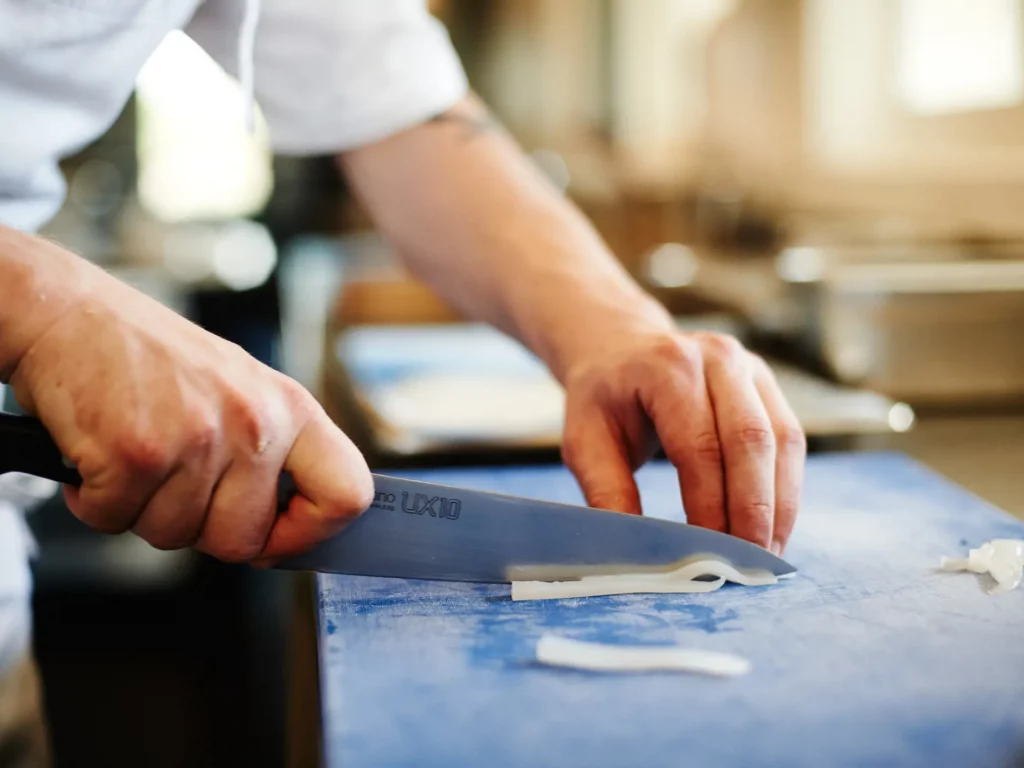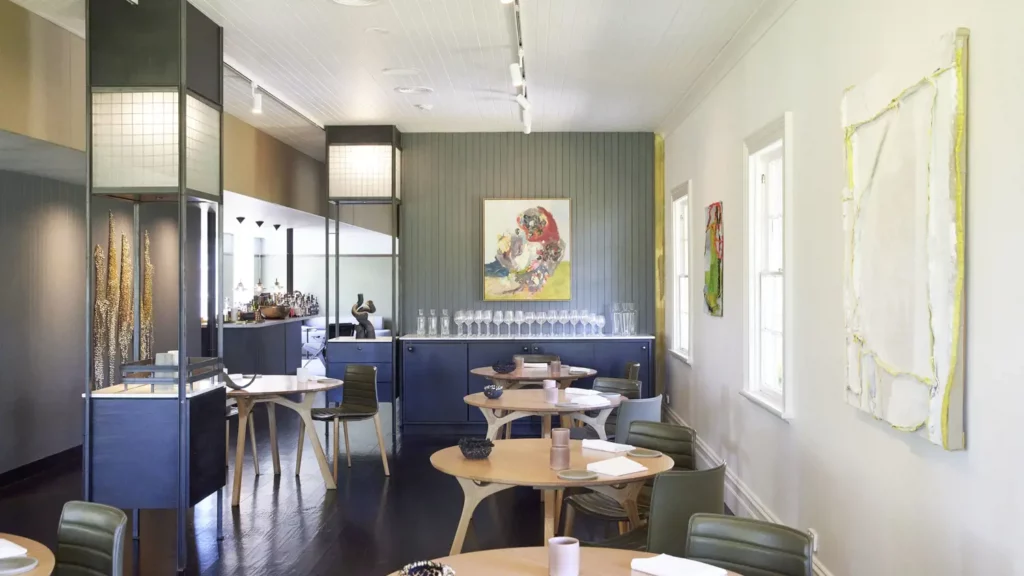Source Seafood Sustainably: Brae
28 October 2024
Share this exclusive content from Saladplate


Photo Credit: Brae, Australia
CHEF DAN HUNTER’S BRAE IS A RESTAURANT, ORGANIC FARM AND BOUTIQUE STAY TUCKED INTO AUSTRALIA’S OTWAYS HILLS. EARLIER THIS YEAR, BRAE ACHIEVED AN IMPRESSIVE THREE-STAR SCORE IN ITS FIRST FOOD MADE GOOD EVALUATION, MAKING IT THE FIRST RESTAURANT IN AUSTRALIA TO BE ACCREDITED BY THE SUSTAINABLE RESTAURANT ASSOCIATION.
We spoke with Dan Hunter, Founder and Head Chef at Brae, about how their dedication to the planet and its people shapes everything they do, their thoughtful approach to sourcing seafood and the insights they’ve gained from the Food Made Good Standard on their sustainability journey.
The hospitality industry can be pretty tough on the environment, often overusing the natural and human resources it relies on. But when Dan started Brae 11 years ago, he set out to avoid becoming part of that problem.
With a focus on sustainability and local sourcing, Brae has created a holistic approach to everything they do, which is clearly laid out in their Sustainability Statement on their website. Their on-site regenerative farm now produces up to 90% of the restaurant’s ingredients organically—think vegetables, grains, honey, and native Australian plants. They’ve planted 1,500 native species on their 20-acre property, collect rainwater to irrigate crops, and use solar power to cut CO2 emissions. Their closed-loop composting system has also diverted over 230,000 kg of food and green waste from landfills.
“When we created Brae, we became custodians of 20 acres of productive land, now a regenerative organic farm where the restaurant sits. We take this responsibility seriously, making sure we leave it healthier and more productive than when we arrived,” Dan explains. “We also strive to make a positive impact on the wider ecosystem and everyone we work with—our team, guests, producers, and community—so that future generations inherit a healthy hospitality industry and thriving marine and land ecosystems.”

How Does Brae Source Seafood Sustainably?
The hospitality industry plays a key role in food production, particularly in how fish are sourced. Many diners don’t think about where their fish comes from; they simply enjoy what’s on their plates. By explaining their choices and showcasing the deliciousness of responsibly sourced seafood, chefs can inspire both their peers and diners to rethink their habits. This ripple effect helps environmentally friendly fishers continue their important work and encourages others to improve their practices, ensuring a resilient food system for all.
Dan emphasises, “Restaurants have an enormous amount of power over the food supply, and as climate change accelerates, our fish stocks become ever more fragile. When we, as restaurateurs, are proactive in selecting our seafood from healthy, local ecosystems and talk publicly about these practices, we can shift demand from overfished, exploited stocks, helping to save them from extinction.”

It’s important for us to know transparently who our producers and suppliers are, so we understand exactly where the fish comes from. Dan notes, “We have long-standing relationships with our local fishers and our supplier, Clamms Seafood. We work closely with them to really understand where all our seafood comes from. We only purchase fish sourced from healthy stocks, always looking for ways to minimise harm to marine and freshwater ecosystems while avoiding destructive fishing or farming methods.”
For guidance, they lean on Goodfish.org.au, a fantastic resource that helps them understand each product’s independently assessed sustainability rating specific to their location. They also mention, “Instead of demanding a specific fish to suit a new dish, the product comes first. We only create a new dish once we find an excellent quality, responsibly sourced seafood product.”

On Brae’s menu, you’ll find wild Tasmanian Angasi Oysters, native to Northeast Tasmania’s Georges Bay. Hand-dived by custodian Dale Ridgers, these oysters are harvested without harming the marine ecosystem. The fishery operates under strict quotas, limiting availability from May to November to ensure stock sustainability.
Aquna Sustainable Murray Cod is another standout. This fish is produced in a closed-loop system that protects native waterways, reuses water for irrigation, and generates zero organic waste. Broodstock is bred in hatcheries, so they’re not reliant on wild-caught juveniles. They also participate in a government restocking program, having released over 20 million fingerlings into the Murray-Darling river system.
Additionally, Brae has started serving long spine sea urchin, which is native to Australia. Their numbers have surged dramatically due to climate change and overfishing of their predators, making them pests that threaten kelp forests—critical ecosystems for many marine species. Brae collaborates with sea urchin fisheries that aim to reduce their populations and restore damaged ecosystems. The urchins are collected by hand, ensuring minimal harm to other marine life.
In high-end dining, using high-quality ingredients that are also good for the environment should be a must, not just an option. Diners shouldn’t have to wonder if their food is sourced responsibly; it should be something they can trust. After all, when you’re paying a premium price for a meal, it’s reasonable to expect that the restaurant supports farmers and producers who take care of the planet while serving up delicious food.
Dan adds, “Guests can relax and indulge guilt-free, knowing that sustainability is taken care of. This builds trust, helps us share our story, and solidifies Brae as a brand of authority and integrity—one that is relied upon for quality, transparency, and values that benefit our environment and community.”


Photo credit: Brae, Australia
Food Mode Good at Brae
Since 2017, Brae has followed the Food Made Good Standard, which serves as the basis for the preliminary assessment in the World’s 50 Best Restaurants Sustainability Award—a process we’ve judged for many years. Dan explains, “This gave us valuable insight into the multi-faceted approach we needed to adopt to become a truly responsible hospitality business. We soon began using it as a framework for our decision-making.”
With the global launch of the Standard in 2023, Brae could finally complete certification in Australia. Dan reflects, “By this stage, we were seeking a trusted accreditation to set us apart from others who may claim to be ‘sustainable’ without fully understanding what a 360-degree, holistic approach to sustainability means.”
The Standard’s rigorous process, requiring real, measurable results, provided Brae with the certification they needed to show they’re truly making a difference. Dan shares, “I was surprised by the rigour of the assessment, the time needed, and the level of supporting evidence required. This is by no means a negative—I was glad to see that achieving the three-star rating was so challenging. It gives the rating weight by rewarding only proven, specific, measurable outcomes.”
Dan also highlights the importance of using the Standard’s language and tools for storytelling, which is key for effectively communicating with both customers and staff. “The Standard has helped us understand the importance of storytelling. Even though we’d been doing a lot of the right things, if we’re not communicating this effectively with our team, guests, and suppliers, we’re not able to reap the benefits. We now have the language, understanding, and authority to speak as one of the leaders in sustainability within our industry.”

What’s Next for Brae?
Recognising the value of having all policies and strategies clearly documented, Dan reflects, “We’ve got some work to do to formalise our written strategies and operational policies. This will help us communicate our goals more effectively with our team and suppliers and allow us to keep improving our practices. We’re still a work in progress.”

Photo Credit: Brae, Australia

Photo Credit: Brae, Australia

Source: The Sustainable Restaurant Association



